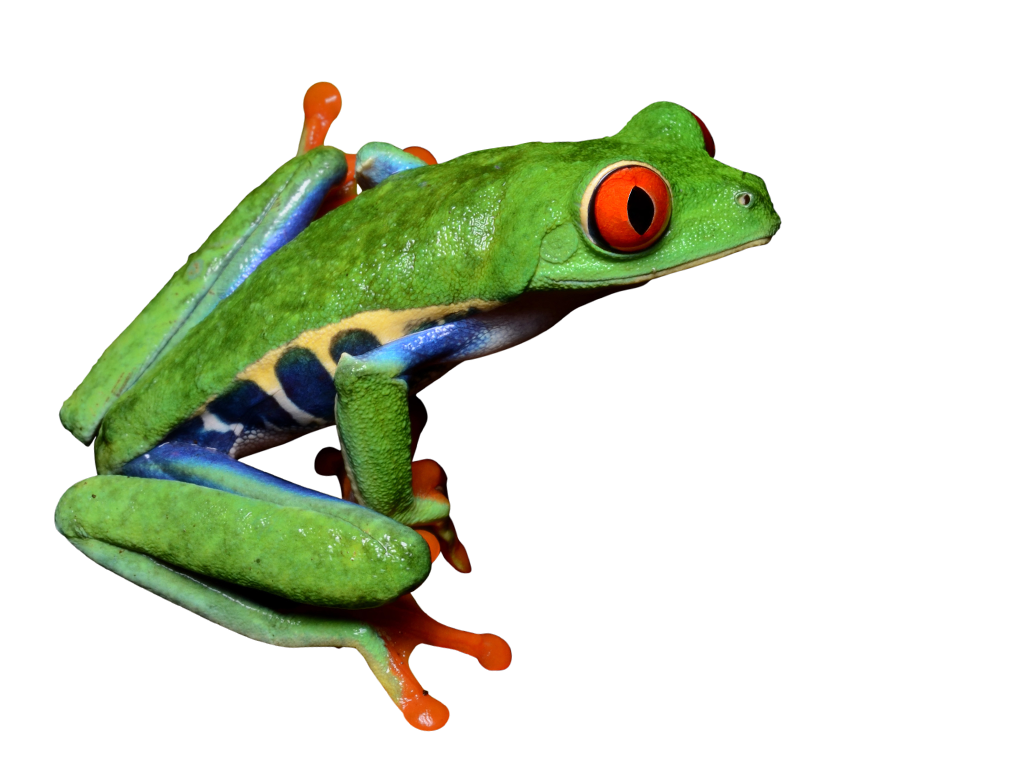Red-eyed tree frog
Agalychnis callidryas

Intimidates with its big red eyes
The red-eyed tree frog inhabits the tropical and humid rainforest, near water. During the day, the red-eyed tree frog rests, preferably on the underside of leaves! Beneath their feet they have strong suction cups, which stick to most surfaces and allow the frog to sleep hanging upside down. The green colour makes it well camouflaged against the leaves when it sleeps. But when the frog is awake, or disturbed from its sleep, it displays other colours too! When the frog wakes up, large, fiery red eyes pop out, something that might frighten a predator. On its side, the frog has vibrant blue and yellow colours, perhaps to fool predators into thinking it is poisonous to eat. The red-eyed tree frog has long legs, and is a very good climber. At night it is active and hunts insects.
When the red-eyed tree frog is resting, it looks like this…
Photo: Bernard-DUPONT-CC-BY-NC-SA
...and when it wakes up, it looks like this!
Photo: Geoff-Gallice-CC-BY
Males crowd on the back of the female
During mating season, there is fierce competition between males for the female red-eyed tree frogs. The males gather around pools of water where they chirp and croak loudly, puff themselves up, shake their bodies and fight to prove that they are the strongest and best in order to be chosen by a female. The spectacle ends with one or more of the males latching onto the female’s back. They wrestle and struggle to get the best place to fertilise the eggs of the female.
Nearly all frogs lay their eggs directly in water, but not the red-eyed tree frog! Instead, the female climbs up from the water and lays her eggs in clusters attached to a leaf above a body of water. The male with the best spot on the female’s back fertilises the eggs as they leave her body. The female needs water in her body to be able to lay healthy eggs. Occasionally, as the female jumps into the water to replenish her body for the next batch of eggs, a new male takes over as fertiliser.
When the eggs hatch, the tadpoles drop into the water, where they swim around for their first few years of life. Eventually, the fry begin to develop legs, and their tails shrink and eventually disappear. The process is called metamorphosis, which means transformation. There is almost no similarity at all in appearance between a tadpole and a finished frog!
A red-eyed tree frog resting on the underside of a leaf.
Two red-eyed tree frogs mating.
Photo: Brian-Gratwicke-CC-BY
A cluster of red-eyed tree frog eggs.
Photo: Brian-Gratwicke-CC-BY
Red-eyed tree frog tadpoles developing in the eggs.
Photo: Geoff-Gallice-CC-BY
Starting to decrease in number
The red-eyed tree frog is not currently endangered, but the species is declining in numbers like so many others, due to deforestation, draining of wetlands, and climate change. The species is prey to several species of snakes, monkeys and birds and is susceptible to fungal infections.
Distribution worldwide
Central America.
White marking = Distribution

Threat based on the Red List

Trade regulations
CITES: B-listed.